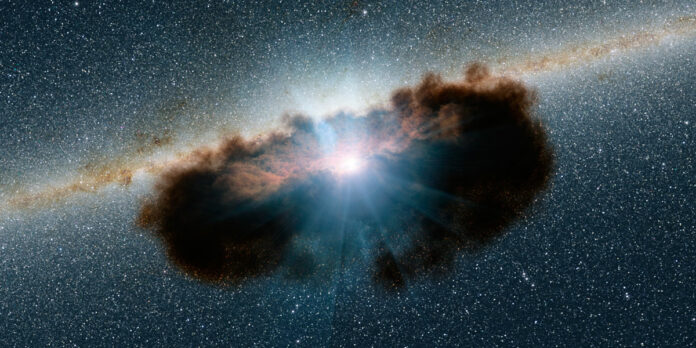A physics graduate student at the University of Alabama in Huntsville is the lead author of a paper in The Astrophysical Journal describing the discovery of an intermediate-size black hole buried in gas and dust in a dwarf galaxy.

intermediate-size black hole in a dwarf galaxy. (Michael Mercier/UAH)
The discovery of the black hole of a previously undiscovered size may help provide clues about how such black holes were seeded in the very early universe.
Obscured from optical observation by heavy dust, the galaxy’s nucleus is powered by the newly discovered intermediate-class black hole, which makes up for size in its mass, said Shrey Ansh.
Typically, galaxies have supermassive black holes at their centers and astronomers can observe them as the surrounding gas and dust fall into them.
Ansh collaborated with principal investigator Dr. Chien-Ting Chen, a scientist at the University Space Research Association Science and Technology Institute and a Marshall Space Flight Center researcher; Dr. Doug Swartz, a USRA STI principal scientist and Marshall researcher; and others internationally to achieve a multi-wavelength analysis of the dwarf galaxy.
“This is one of the first heavily obscured intermediate-mass black holes found in a dwarf galaxy,” said Ansh, who’s originally from India.
Though scientists may call it intermediate, there’s nothing midsized about this monster black hole, which contains 160,000 times the mass of the sun, except its size relative to smaller or larger ones. More massive than typical stellar-mass black holes that are only a few times the mass of the sun, it is smaller in size than the million to billion solar-mass supermassive black holes often found in galaxies.
Chen said the confirmation of the dust obscured monster should give investigators a better idea about how and where to look for more of these objects by combining hard X-ray and mid-infrared emission line observations.
“Although Spitzer is no longer operating, it’s got an even more powerful successor in the
James Webb Space Telescope,” he said. “… we should be able to find more of these tiny monsters lurking in our cosmic neighborhood, and get closer to having a complete census of the black hole population in dwarf galaxies.”
Don’t miss out! Subscribe to our email newsletter to have all our smart stories delivered to your inbox.



